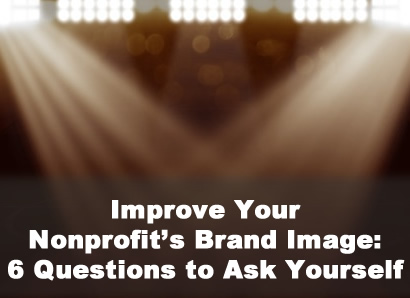Nonprofits need a powerful brand image to compete in an ever growing pool of charities. More than 1.5 million nonprofits are now registered in the United States, and the ones that best relay their mission, purpose, uniqueness, and efficacy with a clear, consistent message are the ones that are succeeding in both raising funds and positively impacting their communities. Consider the following six questions to determine how you can best improve your nonprofit brand image. (More about branding.)
1. What do you do as an organization?
List all of your programs, big and small. Then, write down your mission and goals. Rank your programs based on how well they fit with your stated mission and goals. You might find that you have evolved away from your mission, or that you have taken on programs that do not relate well to your mission. The best brands and most powerful nonprofits have little “mission drift” and can relate all of their work back to their central goals. Before you focus on branding, you might need to refocus your work areas or even your core purpose, so be honest!
2. Who else does what you do?
Understanding the competition is critical to branding because it reveals how you are different and unique in your field. It also identifies partner opportunities to improve your brand image and increase your impact. Businesses call this your threats and opportunities analysis.
List out all organizations that do similar or overlapping work. Determine how your work is both different from each and compatible with each. For instance, if you are a nonprofit that helps homeless youth find jobs, you would list the shelters in your area. Those that do not have job development programs are potential venues and partners for your services. Those that do have job development programs might be serving a different segment of the community or might have a different training approach. No detail is too small! Identify everything, and you will start to see a pattern of how you are particularly unique.
3. Who do you serve?
Identify exactly who you serve – how many people daily, monthly, and annually both directly and indirectly. Also determine their demographics to the finest points possible. How old are they? Do they represent a particular minority group? This step is important because you might find, in your mission to serve youth, you work with a good number of adults that might need to be reached through a different image approach. The best branding appeals to all of your demographic but most strongly to your heaviest client base or potential client base.
4. What would happen if you didn’t do it?
Identify critical needs for your work and expand your impact to indirect benefits as well as direct impacts on clients. If the fictional nonprofit for homeless youth above hadn’t found 142 jobs last year, those youth would not just be on the streets potentially starving, but statistically 30% also might have committed a crime and up to 20% might have become addicts. That work would hence translate to up to $3 million tax dollars saved in community social service and criminal system expenses.
5. How do you see yourself?
The best brands are democratic across their staff, board, and volunteer base. Ask everyone to participate in building your brand!
This can be fun. One approach is to identify three to five cartoon characters, singers, or movie stars that have different personalities that reflect a set of identified values. Are you a Justin Bieber or a Bruce Springsteen nonprofit? Send the question to everyone and ask them to pick the one that most closely resembles your organizational personality. Your logo, brand message, and ultimately your selected advertising outlets will be a reflection of this personality.
6. How do you want the community to see you?
Maybe you are a Bruce Springsteen nonprofit but you want to be a Justin Bieber organization! If so you need to change the way you are presenting yourself.
List all of the values that you want the community to associate with you. Then incorporate those values into your tag lines, your marketing materials, and your logo.
If you are stuck on identifying values, try defining your community as your potential funding base. You can list the top five dream donors to your cause and determine what values they have and want to see in you. What values do the nonprofits they already fund share with your vision, and what are you lacking to appeal to them?
Large nonprofits hire specialists to change or tweak their image, but it is not so difficult for smaller nonprofits. One quick tip is to identify organizations that have the image you want and to partner with them! Like good friends that see each other often, your brand will start to take on the personality of your partner and evolve naturally.
Improving your brand image may sound like a daunting task best assigned to Fortune 500 marketing professionals. Don’t be scared! In short, all it entails is knowing who you are, what you do, and who you do it for and relaying that message to your community. Taking the time to develop that brand image can really help you shine amongst the competition and improve your ability to meet your goals.

